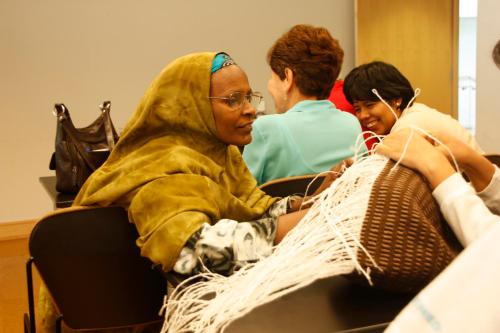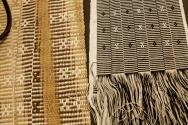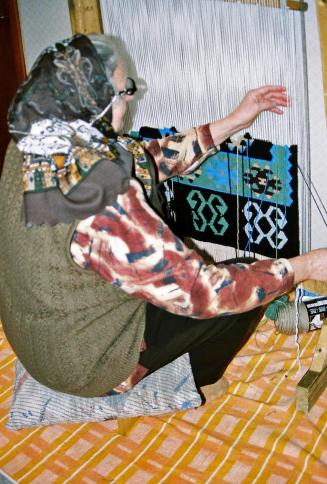Sewing Circle Project Meeting, 2009
SubjectPortrait of
Fatuma Ahmed
(Somali)
SubjectPortrait of
Fatima Vejzovic
(Bosnian)
SubjectPortrait of
Edina Udovcic
(Bosnian)
SubjectPortrait of
Mary Becker
SubjectPortrait of
Nilofer Haider
SubjectPortrait of
Lynne Williamson
Date2009 July 8
Mediumborn digital photography
ClassificationsGraphics
Credit LineConnecticut Cultural Heritage Arts Program collections
CopyrightCopyright held by Lynne Ciccaglione
Object number2015.196.1001.1-.33
DescriptionPhotographs of the Sewing Circle project with several participants meeting at the Hartford Public Library on July 8, 2009. The meeting included a presentation of the Girl Scout project by Christina Garbarino who made a quilt with the Sewing Circle women.
(.1) Image of Somali basketmaker Fatuma Ahmed.
(.2-.3) Images of Burmese Karen weavings.
(.4-.9) Images of members of the Sewing Circle working on their textiles.
(.10) Image of Fatuma Ahmed and Fatima Vejzovic observing a Burmese artist doing an intricate knitting project.
(.11) Image of a Burmese artist doing an intricate knitting project.
(.12) Image of Sewing Circle participants observing Bosnian artist Edina Udovcic working on the intricate knitting project.
(.13) Image of Sewing Circle participants Mary Becker, Fatima Vejzovic, and Fatuma Ahmed.
(.14) Image of Sewing Circle participants observing Bosnian artist Edina Udovcic working on the intricate knitting project.
(.15-.17) Images of Fatuma Ahmed.
(.18-.26) Images of the presentation of the Girl Scout Gold Award quilt project organized by Christima Garbarino.
(.27) Image of the group that worked on the quilt project with Christina Garbarino.
(.28-.31) Images of the quilt made in the Girl Scout Gold Award project.
(.32) Image of Sewing Circle Project organizers Nilofer Haider and Lynne Williamson with Christina Garbarino.
(.33) Image of Christina Garbarino with her mother and the project quilt.
NotesSubject Note: The Sewing Circle Project began in 2007 as an initiative to encourage production, marketing, and sustainability of traditional crafts among the many immigrant and refugee communities in the Greater Hartford area and across the state. Developed by the Connecticut Cultural Heritage Arts Program based at the Institute for Community Research (ICR) in Hartford and at the Connecticut Historical Society after 2015, the project supported the remarkable traditional arts of these newcomers. Members of the Sewing Circle met regularly at ICR and also at the Hartford Public Library to work on their art forms, learn new skills, and share coffee and conversation. This cooperative environment fostered social interaction among the artists and public audiences, respected and encouraged their cultural heritage and artistic traditions, stimulated literacy improvement, and helped to develop marketplaces for their artwork. CCHAP organized gatherings, exhibits, workshops, marketplace events, promotional materials, and educational activities for the group’s participants. While most of the artists experienced war, trauma, and dislocation, they continue to practice their cultural heritage and artistic traditions, blending these with current experiences and materials to create artwork that is both beautiful and functional. Even when immigrants and refugees embrace a move that takes them to a more stable and prosperous place, resettlement poses challenges of physical and psychological adaptation. Many new Americans have eased transition by continuing, recreating, or reinventing familiar art forms. For many members of refugee communities now living in New England, practicing their familiar arts of weaving, knitting, basket making, lace making, music, dance, and storytelling helps them to cope with the trauma of the genocide and displacement their families have suffered. (.1) Image of Somali basketmaker Fatuma Ahmed.
(.2-.3) Images of Burmese Karen weavings.
(.4-.9) Images of members of the Sewing Circle working on their textiles.
(.10) Image of Fatuma Ahmed and Fatima Vejzovic observing a Burmese artist doing an intricate knitting project.
(.11) Image of a Burmese artist doing an intricate knitting project.
(.12) Image of Sewing Circle participants observing Bosnian artist Edina Udovcic working on the intricate knitting project.
(.13) Image of Sewing Circle participants Mary Becker, Fatima Vejzovic, and Fatuma Ahmed.
(.14) Image of Sewing Circle participants observing Bosnian artist Edina Udovcic working on the intricate knitting project.
(.15-.17) Images of Fatuma Ahmed.
(.18-.26) Images of the presentation of the Girl Scout Gold Award quilt project organized by Christima Garbarino.
(.27) Image of the group that worked on the quilt project with Christina Garbarino.
(.28-.31) Images of the quilt made in the Girl Scout Gold Award project.
(.32) Image of Sewing Circle Project organizers Nilofer Haider and Lynne Williamson with Christina Garbarino.
(.33) Image of Christina Garbarino with her mother and the project quilt.
Engaging with public audiences has given project participants a chance to improve their English-speaking skills and broaden their social networks and support systems. The project also brought some additional income to the artists and they became friends and co-workers sharing techniques, styles, and supplies as they created their unusual and exquisite textiles. Through a collaboration with Catholic Charities Migration and Refugee Services and the Hartford Public Library in its early days, the project expanded to offer small business training to the artists, thanks to grants from the Aurora Foundation, the Avon Hello Tomorrow Fund, the Aetna Foundation, and the Knox Foundation. CCHAP worked with the Sewing Circle Project artists to promote their work through marketplace and museum sales, exhibits, demonstrations, and apprenticeships for the experienced artists to teach younger members of their cultural group.
Subject Note: During the summer of 2009, high school student Christina Garbarino from South Windsor, Connecticut proposed to work with the Sewing Circle Project participants on a project that would count towards her Girl Scout Gold Award. Her project was teaching the women in the Sewing Circle how to do quilting and then making a quilt together. Members of the group decided to each make a piece of textile art from their own cultural background and technique. Christina added these into a quilted background that she designed with a cloth globe in the center, covered by a piece of lace made by the Bosnian artists, and surrounded by the individual textile creations made by the women. This beautiful quilt was donated to Hartford Public Library.
Biographical Note: Fatima Vejzovic is a skilled weaver of traditional Bosnian wool flat-weave carpets made on a simple wooden loom constructed by family members in her home. She learned this traditional craft from mothers, aunts, neighbors, and friends in her village, using wool from sheep raised on their farm. After the war Fatima and many weavers worked for Bosfam, a successful crafts cooperative established in Tuzla to assist women with income-generating projects while providing therapeutic and social support. Their work has appeared in catalogues selling the carpets internationally. Fatima arrived in Hartford with her family in 2002. Greater Hartford is now home to over 10,000 Bosnians, most coming as refugees from the war in the former Yugoslavia. For the women in the community, many of them widows, continuing to practice their familiar arts of weaving, knitting, and crochet lace helps them to cope with the trauma of the genocide their families suffered. Fatima’s art works include large floor carpets as well as smaller weavings, and she fashions the woven tapestry fabric into bags, purses, and pillows. Fatima also makes hand-knitted clothes, crochet lace tablecloths, and Bosnian socks worn inside the home. She won a 2021 Connecticut Office of the Arts Fellowship in Folk and Traditional Arts.
Bosnian flat-weave carpets, called ćilimi after their Turkish antecedents (kilims), adorn all parts of the home – floors, walls, chairs and sofas, tables, and beds. The weavings also serve an important function as prayer rugs for these Muslim families. While sometimes made commercially with chemical dyes, the traditional rugs woven by village women still use wool processed by them and colored with natural dyes. Ćilimi designs maintain their Turkish roots but also show European influences stemming from Bosnia’s close connections with Vienna in the early 20th century. Fatima weaves traditional geometric patterns in seemingly endless variations, and she also enjoys adding floral motifs and creating new pictorial designs. Fatima does not use templates or printed patterns – her designs are created as she starts a weaving on the loom, depending on what colors of wool she has available. She developed a new idea for a weaving depicting a whimsical goat, that she made into bags and wall hangings that have become very popular. Fatima also weaves lettering and names into a ćilim, creating a narrative feature that led to a multi-year commission to produce commemorative banners in the organization’s colors for the Aurora Foundation’s retiring board members.
Through a partnership with Clatter Ridge Farm, whose sheep graze on the grounds of the Hill-Stead Museum in Farmington, Connecticut, Fatima has created a series of weavings using their high-quality Shetland wool. The undyed wool gives the rugs a beautiful softness and durability as well as subtle variations of natural color.
Fatima taught her daughter, Fikreta Muratovic, to weave and they worked together for the Bosfam enterprise in Bosnia. As part of the Southern New England Traditional Arts Apprenticeship Program in 2005, Fatima taught loom weaving to a younger Bosnian woman in Hartford, helping to pass on this beloved tradition in their new home. Fatima has given weaving workshops to Hartford students at four schools through Hartford Performs, and to students from Miss Porters School and the Greater Hartford Academy of the Arts. Fatima has worked with three interns from Trinity College through the Sewing Circle Project. As part of the Hartford Performs program for teaching artists in schools, Fatima has taught the basics of loom weaving to students in Hartford, Windsor Locks, and Miss Porter’s School.
Fatima was one of the founding members of the Sewing Circle Project, which began in early 2007 as a partnership to encourage cultural sustainability among the many immigrant and refugee communities in the Greater Hartford area and across Connecticut. Engaging with public audiences has given Fatima opportunities to improve her English-speaking skills, broaden her social networks, and showcase Bosnian cultural traditions. She has demonstrated and sold her work at the Hartford Public Library World Refugee Day; Hartford Open Studio Weekends; the University of Connecticut; the Hill-Stead Museum; the Vermont Folklife Center; the American Folklore Society; the New York Folklore Society; the West Hartford Art League; Ten Thousand Villages; several local house parties; and at the Billings Forge Farmers Market. She enjoys creating new designs for private commissions. Fatima’s work has been included in exhibitions at the Institute for Community Research, the Connecticut Historical Society, the Connecticut Office of the Arts Gallery, and the Clare Gallery.
Biographical Note: Somalia has experienced a complex and continuous civil war among rival clans since 1991, leading to violence, famine, and dislocation for hundreds of thousands of Somalis and Somali Bantus. Fatuma Ahmed, along with her farmer husband and their children, belonged to the Ashraf, a Somali minority group often targeted by larger armed clans. With thousands of others, the family fled across country on donkeys and camels to a large refugee camp in Kenya in 1992. After thirteen years in the camp, Fatuma and her eight children received asylum in the United States, arriving in Hartford in 2005. Although she had not gone to school in Somalia, Fatuma was skilled at handwork with intricate twined designs, making woven sisal mats and baskets that brought some income in the camps. In her new home in Connecticut she continued her basket-making with the Sewing Circle Project organized by CCHAP. Practicing her craft reminded Fatuma of Somali cultural practices, and provided a way to contribute her personal skills to American cultural life. Fatuma moved to Minneapolis in 2014 and went back to live in Somalia in 2018.
Farming families in Somalia, both Somali and Somali Bantu, make mats, baskets, and bags from woven and twined sisal strips or palm leaves. These essential domestic items carry crops and food, store household goods, and transport shopping. Called dambiil in both Somali and Somali Bantu languages, the soft-sided baskets can be plain or patterned. The mats have several uses, each with a different name; they serve as prayer rugs, floor or wall coverings, serving platters, and winnowing trays. In Connecticut Fatuma uses plastic baling twine as the warp to shape the circular basket, then she twists colored yarn around the twine to build up the sides and adds yarn handles. She experimented with colors and basket styles to meet the preferences of the American market. Fatuma would sell her work at the Hartford Farmers Market and other venues, and has taught her daughters the craft.
Biographical Note: Edina Udovcic learned the Bosnian textile arts of weaving and crochet lace in her community in Bosnia. She served as the Bosnian translator for the Sewing Circle Project. Edina has worked at the Hartford Public Library for many years. Three of her crochet lace pieces are in the CHS collection.
Biographical Note: Mary Becker was a long-time volunteer with the Sewing Circle Project, helping to gather donated materials, assisting with travel and set-up at craft shows, and facilitating some of the project meetings.
Biographical Note: Nilofer Haider, who worked as a Catholic Charities Migration and Refugee Services Education Coordinator, was an experienced ESOL teacher for refugees and helped them with resettlement issues. She was an active member of the Pakistani American Cultural Committee, involved in many educational projects in Connecticut. She collaborated with the Sewing Circle Project since its inception, introducing CCHAP to many artists and assisting with program coordination and marketing.
Additional materials exist in the CCHAP archive for this event and the Bosnian community.
Cataloging Note: This project was made possible in part by the Institute of Museum and Library Services MA-245929-OMS-20.
Status
Not on viewFatima Vejzovic
2009 January-February














































